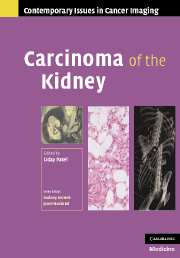Book contents
- Frontmatter
- Contents
- Contributors
- Series foreword
- Preface to Carcinoma of the Kidney
- 1 Renal cell cancer: overview and immunochemotherapy
- 2 Pathology of adult renal parenchymal cancers
- 3 Familial and inherited renal cancers
- 4 Radiological diagnosis of renal cancer
- 5 Staging of renal cancer
- 6 The case for biopsy in the modern management of renal cancer
- 7 Imaging characteristics of unusual renal cancers
- 8 Surgery for renal cancer: current status
- 9 Ablation of renal cancer
- 10 Post-treatment surveillance of renal cancer
- 11 Imaging for nephron-sparing procedures
- Index
- Plate Section
- References
5 - Staging of renal cancer
Published online by Cambridge University Press: 08 August 2009
- Frontmatter
- Contents
- Contributors
- Series foreword
- Preface to Carcinoma of the Kidney
- 1 Renal cell cancer: overview and immunochemotherapy
- 2 Pathology of adult renal parenchymal cancers
- 3 Familial and inherited renal cancers
- 4 Radiological diagnosis of renal cancer
- 5 Staging of renal cancer
- 6 The case for biopsy in the modern management of renal cancer
- 7 Imaging characteristics of unusual renal cancers
- 8 Surgery for renal cancer: current status
- 9 Ablation of renal cancer
- 10 Post-treatment surveillance of renal cancer
- 11 Imaging for nephron-sparing procedures
- Index
- Plate Section
- References
Summary
Introduction: Why stage disease?
The staging of renal tumors is important as it divides them into groups that enable a logical framework for treatment planning, entry into clinical trials, and prognostication. With the increasing use of techniques such as nephron-sparing surgery and laparoscopic surgery the radiological staging information will determine the type of surgical approach. Also, unlike surgery which provides tissue for pathological staging, ablative therapies such as cryotherapy or radiofrequency ablation rely solely on radiological staging, with the occasional benefit of renal biopsy.
History of staging
The first staging system for renal tumors was introduced by Flocks and Kadesky in 1958 and subsequently modified by Robson in 1963. The TNM criteria was introduced in 1978 and revised in 1987, 1997, and most recently in 2002 (Table 5.1). These modifications reflected a change in surgical approach and better understanding of the survival characteristics of the different groups.
The 1997 AJCC (American Joint Committee on Cancer) revision resulted in reclassification of T1 lesions from confined tumors less than or equal to 2.5 cm to those lesions 7 cm or less. Confined tumors measuring greater than 7 cm were classified as T2. A subsequent study demonstrated an 83% 5-year survival for T1 tumors with a 57% 5-year survival for T2 tumors. This major difference in prognosis underlies the rationale for the division between T1 and T2 tumors.
- Type
- Chapter
- Information
- Carcinoma of the Kidney , pp. 91 - 111Publisher: Cambridge University PressPrint publication year: 2007



